wheel FIAT DOBLO COMBI 2010 Owner handbook (in English)
[x] Cancel search | Manufacturer: FIAT, Model Year: 2010, Model line: DOBLO COMBI, Model: FIAT DOBLO COMBI 2010Pages: 274, PDF Size: 6.16 MB
Page 97 of 274
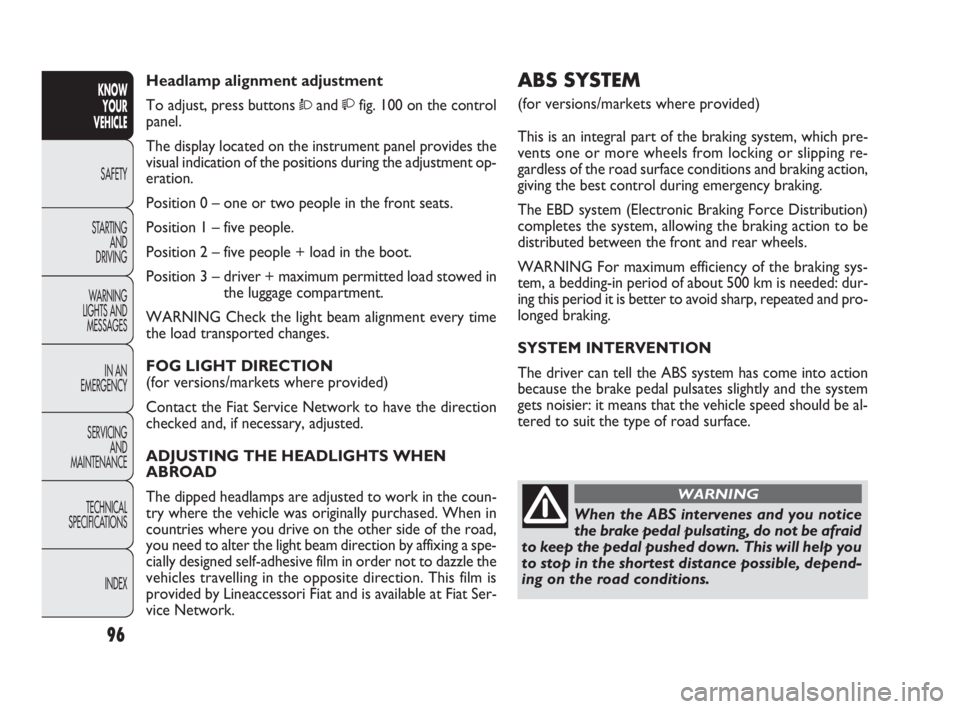
96
KNOW
YOUR
VEHICLE
SAFETY
STARTING
AND
DRIVING
WARNING
LIGHTS AND
MESSAGES
IN AN
EMERGENCY
SERVICING
AND
MAINTENANCE
TECHNICAL
SPECIFICATIONS
INDEX
ABS SYSTEM
(for versions/markets where provided)
This is an integral part of the braking system, which pre-
vents one or more wheels from locking or slipping re-
gardless of the road surface conditions and braking action,
giving the best control during emergency braking.
The EBD system (Electronic Braking Force Distribution)
completes the system, allowing the braking action to be
distributed between the front and rear wheels.
WARNING For maximum efficiency of the braking sys-
tem, a bedding-in period of about 500 km is needed: dur-
ing this period it is better to avoid sharp, repeated and pro-
longed braking.
SYSTEM INTERVENTION
The driver can tell the ABS system has come into action
because the brake pedal pulsates slightly and the system
gets noisier: it means that the vehicle speed should be al-
tered to suit the type of road surface. Headlamp alignment adjustment
To adjust, press buttons Òandfig. 100 on the control
panel.
The display located on the instrument panel provides the
visual indication of the positions during the adjustment op-
eration.
Position 0 – one or two people in the front seats.
Position 1 – five people.
Position 2 – five people + load in the boot.
Position 3 – driver + maximum permitted load stowed in
the luggage compartment.
WARNING Check the light beam alignment every time
the load transported changes.
FOG LIGHT DIRECTION
(for versions/markets where provided)
Contact the Fiat Service Network to have the direction
checked and, if necessary, adjusted.
ADJUSTING THE HEADLIGHTS WHEN
ABROAD
The dipped headlamps are adjusted to work in the coun-
try where the vehicle was originally purchased. When in
countries where you drive on the other side of the road,
you need to alter the light beam direction by affixing a spe-
cially designed self-adhesive film in order not to dazzle the
vehicles travelling in the opposite direction. This film is
provided by Lineaccessori Fiat and is available at Fiat Ser-
vice Network.
When the ABS intervenes and you notice
the brake pedal pulsating, do not be afraid
to keep the pedal pushed down. This will help you
to stop in the shortest distance possible, depend-
ing on the road conditions.
WARNING
035-114 DOBLO LUM EN 2e 7.0 21-05-2010 9:54 Pagina 96
Page 98 of 274
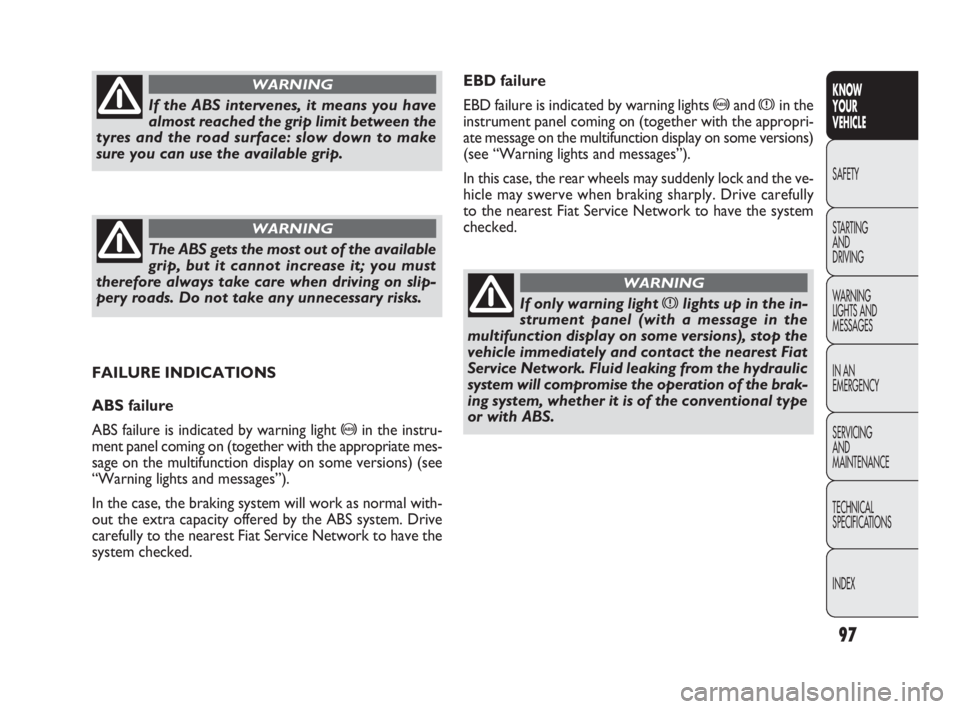
97
KNOW
YOUR
VEHICLE
SAFETY
STARTING
AND
DRIVING
WARNING
LIGHTS AND
MESSAGES
IN AN
EMERGENCY
SERVICING
AND
MAINTENANCE
TECHNICAL
SPECIFICATIONS
INDEX
EBD failure
EBD failure is indicated by warning lights
>andxin the
instrument panel coming on (together with the appropri-
ate message on the multifunction display on some versions)
(see “Warning lights and messages”).
In this case, the rear wheels may suddenly lock and the ve-
hicle may swerve when braking sharply. Drive carefully
to the nearest Fiat Service Network to have the system
checked.
FAILURE INDICATIONS
ABS failure
ABS failure is indicated by warning light
>in the instru-
ment panel coming on (together with the appropriate mes-
sage on the multifunction display on some versions) (see
“Warning lights and messages”).
In the case, the braking system will work as normal with-
out the extra capacity offered by the ABS system. Drive
carefully to the nearest Fiat Service Network to have the
system checked.
If the ABS intervenes, it means you have
almost reached the grip limit between the
tyres and the road surface: slow down to make
sure you can use the available grip.
WARNING
The ABS gets the most out of the available
grip, but it cannot increase it; you must
therefore always take care when driving on slip-
pery roads. Do not take any unnecessary risks.
WARNING
If only warning light xlights up in the in-
strument panel (with a message in the
multifunction display on some versions), stop the
vehicle immediately and contact the nearest Fiat
Service Network. Fluid leaking from the hydraulic
system will compromise the operation of the brak-
ing system, whether it is of the conventional type
or with ABS.
WARNING
035-114 DOBLO LUM EN 2e 7.0 21-05-2010 9:54 Pagina 97
Page 100 of 274
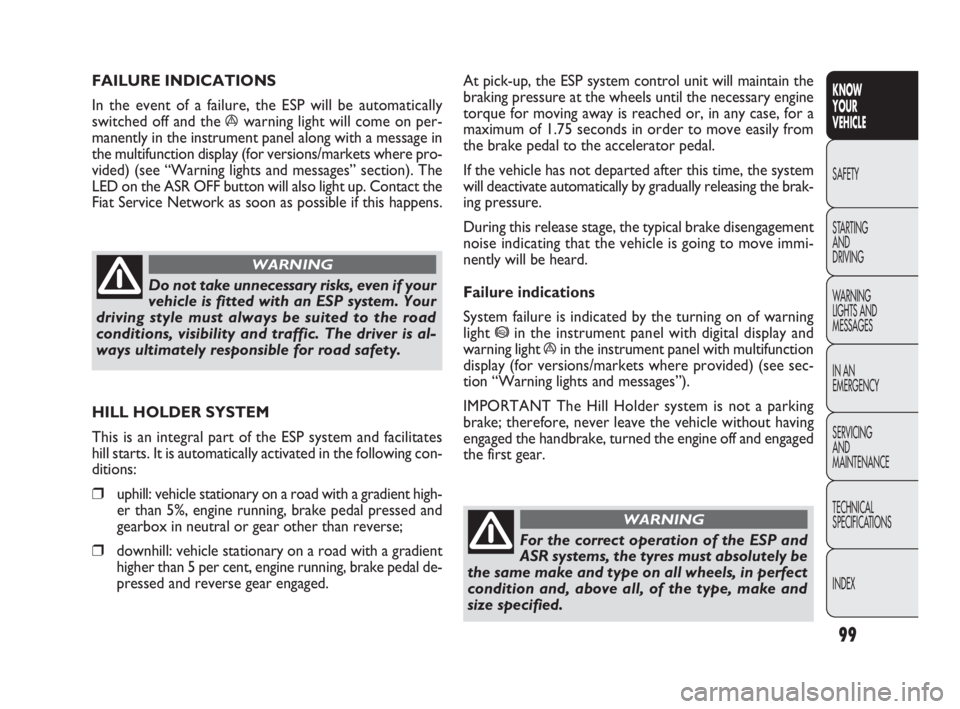
99
KNOW
YOUR
VEHICLE
SAFETY
STARTING
AND
DRIVING
WARNING
LIGHTS AND
MESSAGES
IN AN
EMERGENCY
SERVICING
AND
MAINTENANCE
TECHNICAL
SPECIFICATIONS
INDEX
At pick-up, the ESP system control unit will maintain the
braking pressure at the wheels until the necessary engine
torque for moving away is reached or, in any case, for a
maximum of 1.75 seconds in order to move easily from
the brake pedal to the accelerator pedal.
If the vehicle has not departed after this time, the system
will deactivate automatically by gradually releasing the brak-
ing pressure.
During this release stage, the typical brake disengagement
noise indicating that the vehicle is going to move immi-
nently will be heard.
Failure indications
System failure is indicated by the turning on of warning
light
*in the instrument panel with digital display and
warning light
áin the instrument panel with multifunction
display (for versions/markets where provided) (see sec-
tion “Warning lights and messages”).
IMPORTANT The Hill Holder system is not a parking
brake; therefore, never leave the vehicle without having
engaged the handbrake, turned the engine off and engaged
the first gear. FAILURE INDICATIONS
In the event of a failure, the ESP will be automatically
switched off and the
áwarning light will come on per-
manently in the instrument panel along with a message in
the multifunction display (for versions/markets where pro-
vided) (see “Warning lights and messages” section). The
LED on the ASR OFF button will also light up. Contact the
Fiat Service Network as soon as possible if this happens.
Do not take unnecessary risks, even if your
vehicle is fitted with an ESP system. Your
driving style must always be suited to the road
conditions, visibility and traffic. The driver is al-
ways ultimately responsible for road safety.
WARNING
HILL HOLDER SYSTEM
This is an integral part of the ESP system and facilitates
hill starts. It is automatically activated in the following con-
ditions:
❒uphill: vehicle stationary on a road with a gradient high-
er than 5%, engine running, brake pedal pressed and
gearbox in neutral or gear other than reverse;
❒downhill: vehicle stationary on a road with a gradient
higher than 5 per cent, engine running, brake pedal de-
pressed and reverse gear engaged. For the correct operation of the ESP and
ASR systems, the tyres must absolutely be
the same make and type on all wheels, in perfect
condition and, above all, of the type, make and
size specified.
WARNING
035-114 DOBLO LUM EN 2e 7.0 21-05-2010 9:54 Pagina 99
Page 101 of 274
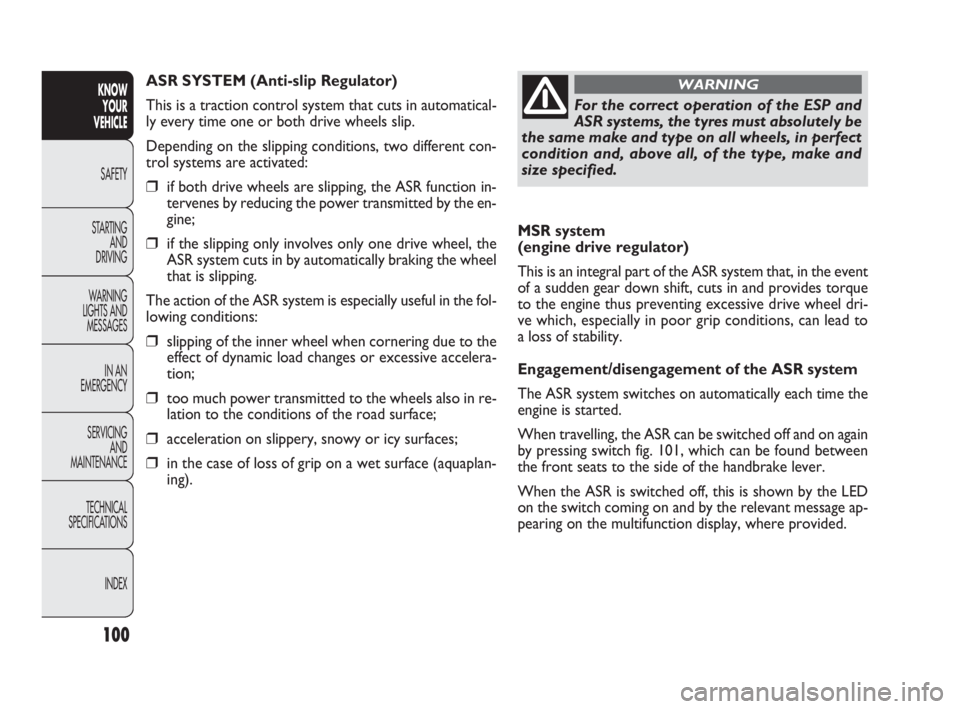
100
KNOW
YOUR
VEHICLE
SAFETY
STARTING
AND
DRIVING
WARNING
LIGHTS AND
MESSAGES
IN AN
EMERGENCY
SERVICING
AND
MAINTENANCE
TECHNICAL
SPECIFICATIONS
INDEX
MSR system
(engine drive regulator)
This is an integral part of the ASR system that, in the event
of a sudden gear down shift, cuts in and provides torque
to the engine thus preventing excessive drive wheel dri-
ve which, especially in poor grip conditions, can lead to
a loss of stability.
Engagement/disengagement of the ASR system
The ASR system switches on automatically each time the
engine is started.
When travelling, the ASR can be switched off and on again
by pressing switch fig. 101, which can be found between
the front seats to the side of the handbrake lever.
When the ASR is switched off, this is shown by the LED
on the switch coming on and by the relevant message ap-
pearing on the multifunction display, where provided. ASR SYSTEM (Anti-slip Regulator)
This is a traction control system that cuts in automatical-
ly every time one or both drive wheels slip.
Depending on the slipping conditions, two different con-
trol systems are activated:
❒if both drive wheels are slipping, the ASR function in-
tervenes by reducing the power transmitted by the en-
gine;
❒if the slipping only involves only one drive wheel, the
ASR system cuts in by automatically braking the wheel
that is slipping.
The action of the ASR system is especially useful in the fol-
lowing conditions:
❒slipping of the inner wheel when cornering due to the
effect of dynamic load changes or excessive accelera-
tion;
❒too much power transmitted to the wheels also in re-
lation to the conditions of the road surface;
❒acceleration on slippery, snowy or icy surfaces;
❒in the case of loss of grip on a wet surface (aquaplan-
ing).
For the correct operation of the ESP and
ASR systems, the tyres must absolutely be
the same make and type on all wheels, in perfect
condition and, above all, of the type, make and
size specified.
WARNING
035-114 DOBLO LUM EN 2e 7.0 21-05-2010 9:54 Pagina 100
Page 102 of 274
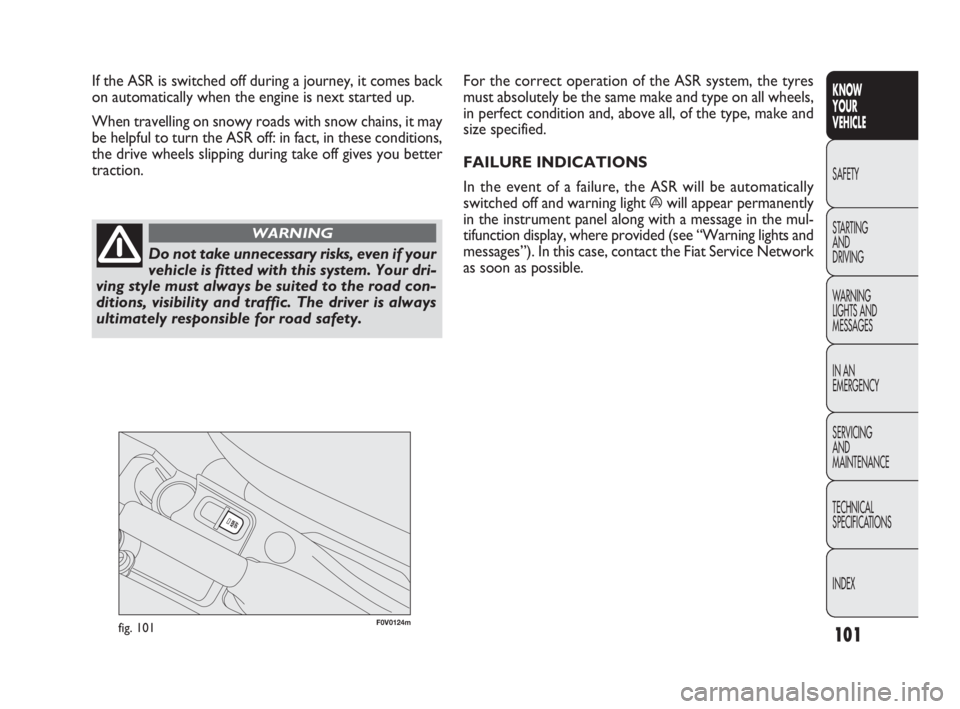
101
KNOW
YOUR
VEHICLE
SAFETY
STARTING
AND
DRIVING
WARNING
LIGHTS AND
MESSAGES
IN AN
EMERGENCY
SERVICING
AND
MAINTENANCE
TECHNICAL
SPECIFICATIONS
INDEX
F0V0124mfig. 101
For the correct operation of the ASR system, the tyres
must absolutely be the same make and type on all wheels,
in perfect condition and, above all, of the type, make and
size specified.
FAILURE INDICATIONS
In the event of a failure, the ASR will be automatically
switched off and warning light
áwill appear permanently
in the instrument panel along with a message in the mul-
tifunction display, where provided (see “Warning lights and
messages”). In this case, contact the Fiat Service Network
as soon as possible. If the ASR is switched off during a journey, it comes back
on automatically when the engine is next started up.
When travelling on snowy roads with snow chains, it may
be helpful to turn the ASR off: in fact, in these conditions,
the drive wheels slipping during take off gives you better
traction.
Do not take unnecessary risks, even if your
vehicle is fitted with this system. Your dri-
ving style must always be suited to the road con-
ditions, visibility and traffic. The driver is always
ultimately responsible for road safety.
WARNING
035-114 DOBLO LUM EN 2e 7.0 21-05-2010 9:54 Pagina 101
Page 129 of 274
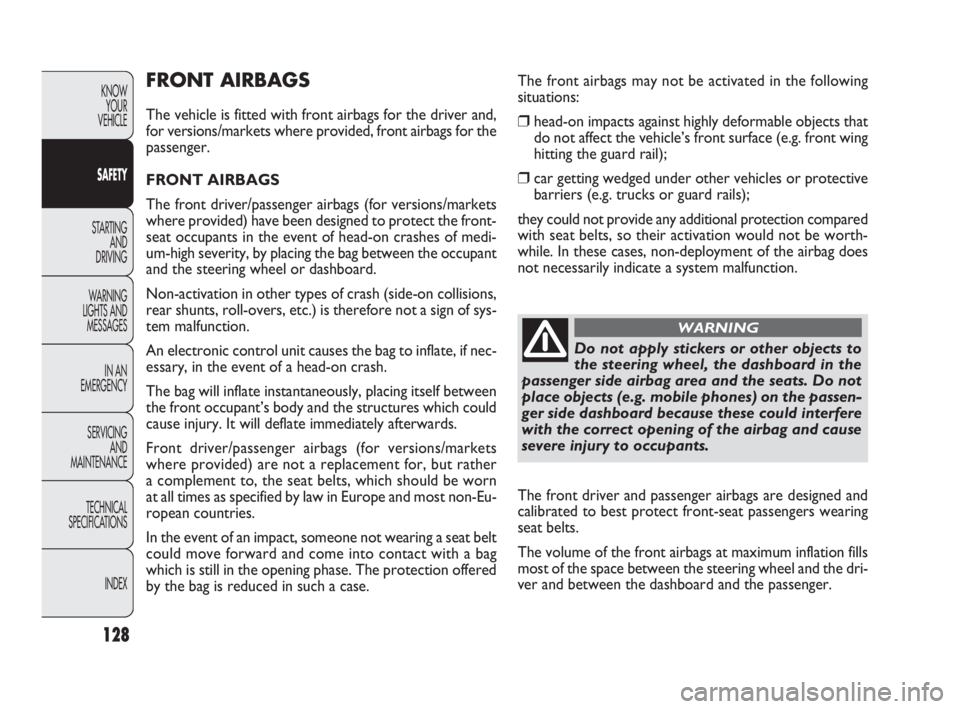
128
KNOW
YOUR
VEHICLE
SAFETY
STARTING
AND
DRIVING
WARNING
LIGHTS AND
MESSAGES
IN AN
EMERGENCY
SERVICING
AND
MAINTENANCE
TECHNICAL
SPECIFICATIONS
INDEX
FRONT AIRBAGS
The vehicle is fitted with front airbags for the driver and,
for versions/markets where provided, front airbags for the
passenger.
FRONT AIRBAGS
The front driver/passenger airbags (for versions/markets
where provided) have been designed to protect the front-
seat occupants in the event of head-on crashes of medi-
um-high severity, by placing the bag between the occupant
and the steering wheel or dashboard.
Non-activation in other types of crash (side-on collisions,
rear shunts, roll-overs, etc.) is therefore not a sign of sys-
tem malfunction.
An electronic control unit causes the bag to inflate, if nec-
essary, in the event of a head-on crash.
The bag will inflate instantaneously, placing itself between
the front occupant’s body and the structures which could
cause injury. It will deflate immediately afterwards.
Front driver/passenger airbags (for versions/markets
where provided) are not a replacement for, but rather
a complement to, the seat belts, which should be worn
at all times as specified by law in Europe and most non-Eu-
ropean countries.
In the event of an impact, someone not wearing a seat belt
could move forward and come into contact with a bag
which is still in the opening phase. The protection offered
by the bag is reduced in such a case. The front airbags may not be activated in the following
situations:❒head-on impacts against highly deformable objects that
do not affect the vehicle’s front surface (e.g. front wing
hitting the guard rail);
❒car getting wedged under other vehicles or protective
barriers (e.g. trucks or guard rails);
they could not provide any additional protection compared
with seat belts, so their activation would not be worth-
while. In these cases, non-deployment of the airbag does
not necessarily indicate a system malfunction.
Do not apply stickers or other objects to
the steering wheel, the dashboard in the
passenger side airbag area and the seats. Do not
place objects (e.g. mobile phones) on the passen-
ger side dashboard because these could interfere
with the correct opening of the airbag and cause
severe injury to occupants.
WARNING
The front driver and passenger airbags are designed and
calibrated to best protect front-seat passengers wearing
seat belts.
The volume of the front airbags at maximum inflation fills
most of the space between the steering wheel and the dri-
ver and between the dashboard and the passenger.
115-132 DOBLO LUM EN 2e 7.0 21-05-2010 11:11 Pagina 128
Page 130 of 274
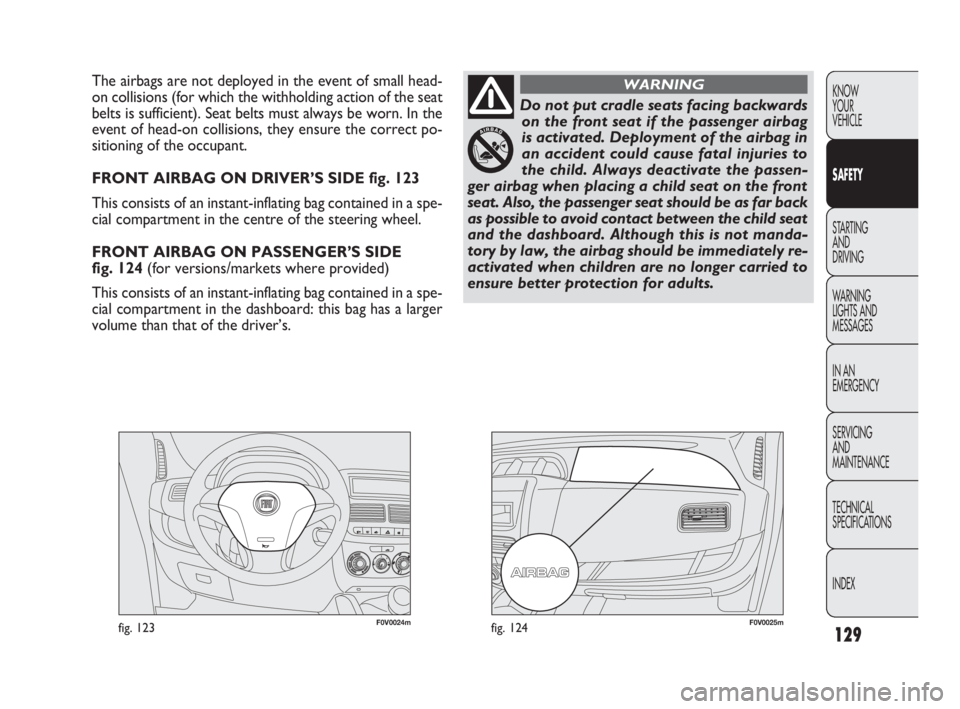
129
KNOW
YOUR
VEHICLE
SAFETY
STARTING
AND
DRIVING
WARNING
LIGHTS AND
MESSAGES
IN AN
EMERGENCY
SERVICING
AND
MAINTENANCE
TECHNICAL
SPECIFICATIONS
INDEX
F0V0024mfig. 123F0V0025mfig. 124
The airbags are not deployed in the event of small head-
on collisions (for which the withholding action of the seat
belts is sufficient). Seat belts must always be worn. In the
event of head-on collisions, they ensure the correct po-
sitioning of the occupant.
FRONT AIRBAG ON DRIVER’S SIDE fig. 123
This consists of an instant-inflating bag contained in a spe-
cial compartment in the centre of the steering wheel.
FRONT AIRBAG ON PASSENGER’S SIDE
fig. 124 (for versions/markets where provided)
This consists of an instant-inflating bag contained in a spe-
cial compartment in the dashboard: this bag has a larger
volume than that of the driver’s.
Do not put cradle seats facing backwards
on the front seat if the passenger airbag
is activated. Deployment of the airbag in
an accident could cause fatal injuries to
the child. Always deactivate the passen-
ger airbag when placing a child seat on the front
seat. Also, the passenger seat should be as far back
as possible to avoid contact between the child seat
and the dashboard. Although this is not manda-
tory by law, the airbag should be immediately re-
activated when children are no longer carried to
ensure better protection for adults.
WARNING
115-132 DOBLO LUM EN 2e 7.0 21-05-2010 11:11 Pagina 129
Page 137 of 274
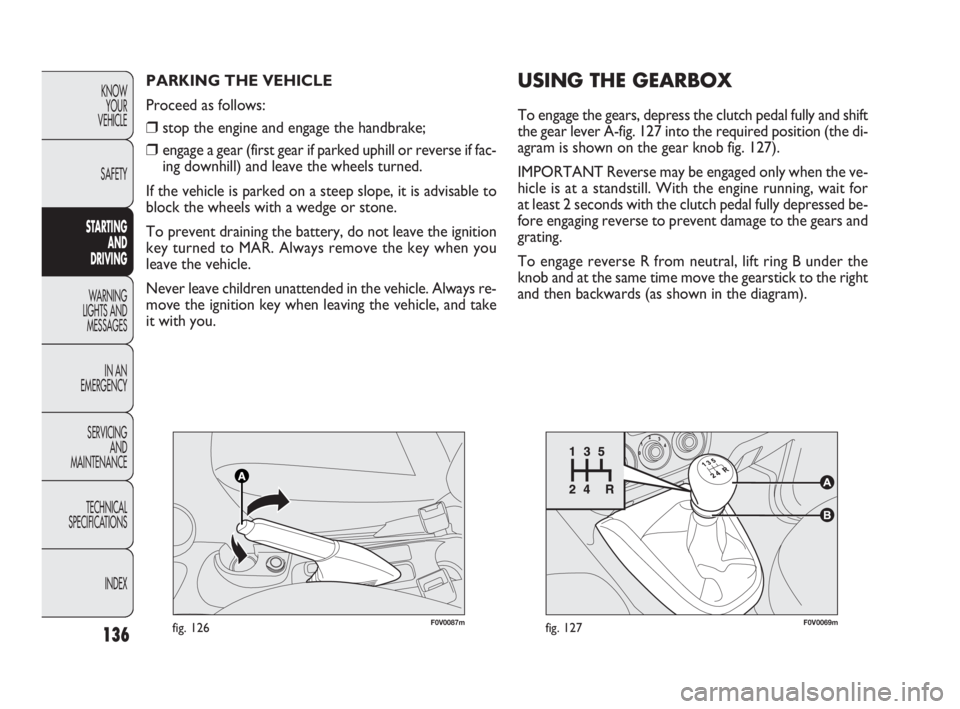
136
KNOW
YOUR
VEHICLE
SAFETY
STARTING
AND
DRIVING
WARNING
LIGHTS AND
MESSAGES
IN AN
EMERGENCY
SERVICING
AND
MAINTENANCE
TECHNICAL
SPECIFICATIONS
INDEX
F0V0069mfig. 127F0V0087mfig. 126
PARKING THE VEHICLE
Proceed as follows:
❒stop the engine and engage the handbrake;
❒engage a gear (first gear if parked uphill or reverse if fac-
ing downhill) and leave the wheels turned.
If the vehicle is parked on a steep slope, it is advisable to
block the wheels with a wedge or stone.
To prevent draining the battery, do not leave the ignition
key turned to MAR. Always remove the key when you
leave the vehicle.
Never leave children unattended in the vehicle. Always re-
move the ignition key when leaving the vehicle, and take
it with you.
USING THE GEARBOX
To engage the gears, depress the clutch pedal fully and shift
the gear lever A-fig. 127 into the required position (the di-
agram is shown on the gear knob fig. 127).
IMPORTANT Reverse may be engaged only when the ve-
hicle is at a standstill. With the engine running, wait for
at least 2 seconds with the clutch pedal fully depressed be-
fore engaging reverse to prevent damage to the gears and
grating.
To engage reverse R from neutral, lift ring B under the
knob and at the same time move the gearstick to the right
and then backwards (as shown in the diagram).
133-142 DOBLO LUM EN 2e 7.0 21-05-2010 11:12 Pagina 136
Page 141 of 274
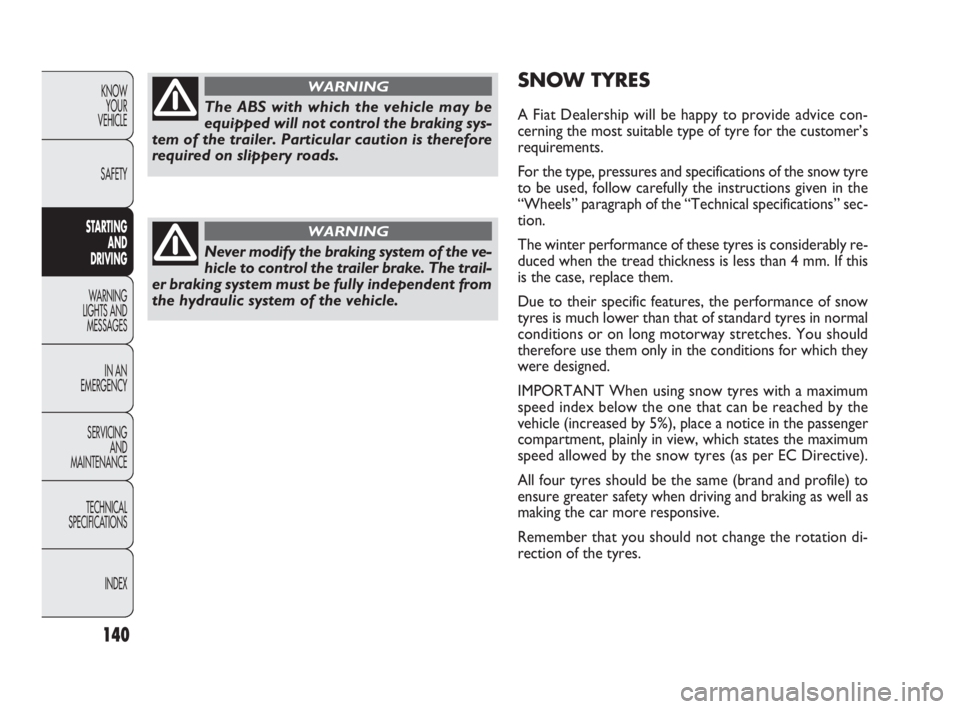
140
KNOW
YOUR
VEHICLE
SAFETY
STARTING
AND
DRIVING
WARNING
LIGHTS AND
MESSAGES
IN AN
EMERGENCY
SERVICING
AND
MAINTENANCE
TECHNICAL
SPECIFICATIONS
INDEX
SNOW TYRES
A Fiat Dealership will be happy to provide advice con-
cerning the most suitable type of tyre for the customer’s
requirements.
For the type, pressures and specifications of the snow tyre
to be used, follow carefully the instructions given in the
“Wheels” paragraph of the “Technical specifications” sec-
tion.
The winter performance of these tyres is considerably re-
duced when the tread thickness is less than 4 mm. If this
is the case, replace them.
Due to their specific features, the performance of snow
tyres is much lower than that of standard tyres in normal
conditions or on long motorway stretches. You should
therefore use them only in the conditions for which they
were designed.
IMPORTANT When using snow tyres with a maximum
speed index below the one that can be reached by the
vehicle (increased by 5%), place a notice in the passenger
compartment, plainly in view, which states the maximum
speed allowed by the snow tyres (as per EC Directive).
All four tyres should be the same (brand and profile) to
ensure greater safety when driving and braking as well as
making the car more responsive.
Remember that you should not change the rotation di-
rection of the tyres.The ABS with which the vehicle may be
equipped will not control the braking sys-
tem of the trailer. Particular caution is therefore
required on slippery roads.
WARNING
Never modify the braking system of the ve-
hicle to control the trailer brake. The trail-
er braking system must be fully independent from
the hydraulic system of the vehicle.
WARNING
133-142 DOBLO LUM EN 2e 7.0 21-05-2010 11:12 Pagina 140
Page 142 of 274
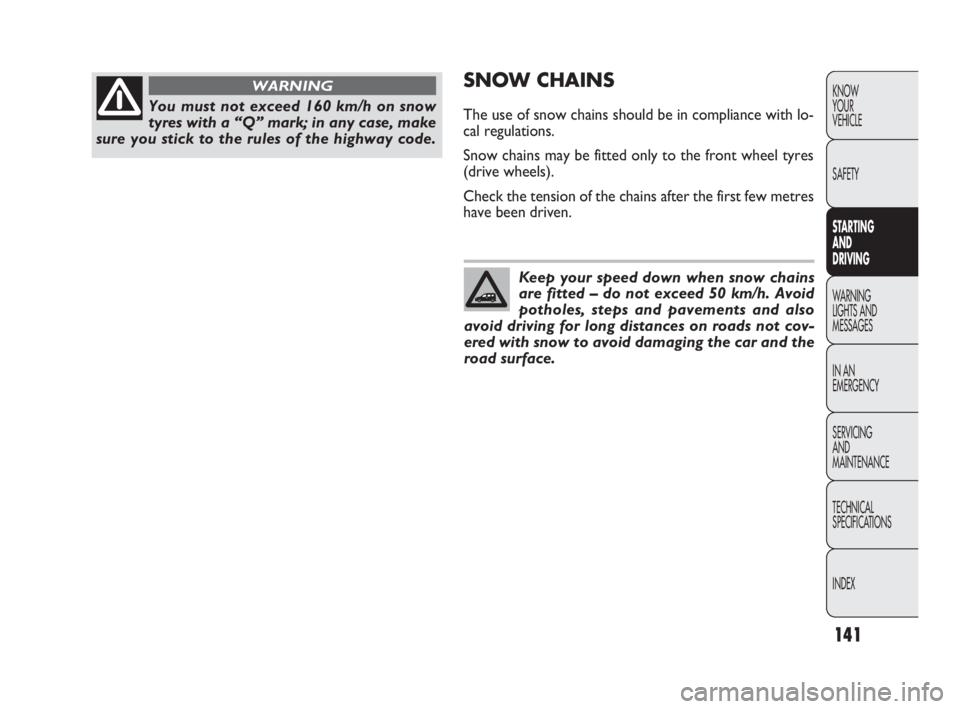
141
KNOW
YOUR
VEHICLE
SAFETY
STARTING
AND
DRIVING
WARNING
LIGHTS AND
MESSAGES
IN AN
EMERGENCY
SERVICING
AND
MAINTENANCE
TECHNICAL
SPECIFICATIONS
INDEX
SNOW CHAINS
The use of snow chains should be in compliance with lo-
cal regulations.
Snow chains may be fitted only to the front wheel tyres
(drive wheels).
Check the tension of the chains after the first few metres
have been driven.You must not exceed 160 km/h on snow
tyres with a “Q” mark; in any case, make
sure you stick to the rules of the highway code.
WARNING
Keep your speed down when snow chains
are fitted – do not exceed 50 km/h. Avoid
potholes, steps and pavements and also
avoid driving for long distances on roads not cov-
ered with snow to avoid damaging the car and the
road surface.
133-142 DOBLO LUM EN 2e 7.0 21-05-2010 11:12 Pagina 141